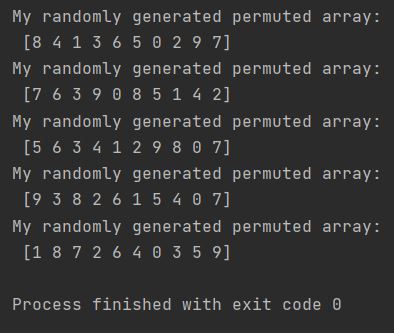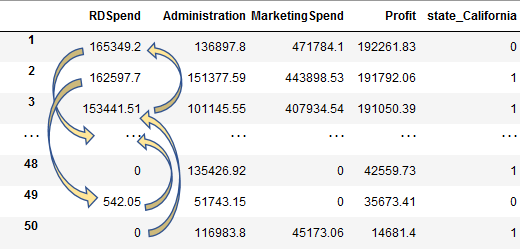

Examples: Input : str ABC Output : ABC ACB BAC BCA CAB CBA. If x is an integer, randomly permute np.arange(x). A permutation, also called an arrangement number or order, is a rearrangement of the elements of an ordered list S into a one-to-one correspondence with S itself. If x is a multi-dimensional array, it is only shuffled along its first index. In the Fisher-Yates Algorithm, the start point will be 0 and the stop point will be the length of the list minus 1 for the randint() method. ¶ (x) ¶ Randomly permute a sequence, or return a permuted range. If x is an array, make a copy and shuffle the elements randomly. If x is an integer, randomly permute np.arange (x). The randint() method generates a random integer value between the start and stops points that we provide. Randomly permute a sequence, or return a permuted range. The algorithm goes through a list in reverse, starting from the last index, and uses a method in python, called randint(). The Fisher-Yates Algorithm uses the index to shuffle the items of the list. Indexes start at 0 from the first item in a list and go in sequential order to the last item in a list. Then the process to access a number say 28 would be Lis, where 1 is the index of 28. An index is a number inside the memory that can be used to access elements in a list. The Fisher-Yates Algorithm provides a technique to shuffle the items in a list by swapping the place of an item with another item from a random index in the list. There are 03 methods to shuffle a list in python, Fisher-Yates Shuffle Algorithm, the shuffle method, and the sampling method.
#Randomly permute python code#
Have a look at the code below to understand this further: We will be shuffling the list in python using sample() function. To do this you either use empty square braces or the list() function with no arguments. Random shuffle the list in python using sample() function. Parameters: xarraylike, at least one-dimensional. You can also create empty lists to which you can add elements later in your code. Randomly permute a sequence, or return a permuted range. Unlike shuffle, each slice along the given axis is shuffled independently of the others. You can pass all the items that you want to include in the list inside the list() function and it will return a list with all the items. The other method is to use the list() function to create a list.

There are two methods that can be used to declare a list in python, the first method is to enclose all the items that we want to include in the list inside square braces. Similarly, in python, you can create a list that allows you to store multiple items under one name and then use that name to access all the items. The list will be a sequence of items that you need to buy and you can use the list to see what item to buy at any time. Too much technical jargon? Well, imagine that scenario that your mom is sending you out to get groceries, she will hand you some money and along with that a list. What is a list in python?Ī list in python is a data structure that provides sequential access to a collection of items.

And Yes, you can do it with and without using the shuffle command.
#Randomly permute python how to#
In this article, we will learn how to shuffle a list in python. There is a need to shuffle a given set of items. Nah, thats because of the random.random() line you have there which consumes one random number and changes the state of the Random object. A sequence can be shuffled using it (like a list or a tuple) in Python shuffling means.

In various cases of programming, you will be required to shuffle a given set of items. The random package of Python has a built-in function shuffle(). What is that step? These three games require shuffling. What do all three of these games have in common? All of them require a step to be performed. Once you have created the slice of integers, you can populate it with integers in ascending order using a for loop.A lottery, a lucky draw, and a card game. In this example, we are creating a slice of integers with a length of length. You can create a slice of integers using the make function and specifying the length of the slice. The first step to generating a random permutation of integers in Go is to create a slice of integers. In this article, we will explore how to generate a random permutation of integers in Go. Generating a random permutation is a common task in programming, and Go provides a built-in package for generating random permutations of integers. A random permutation of integers is a sequence of integers that has been shuffled randomly.


 0 kommentar(er)
0 kommentar(er)
